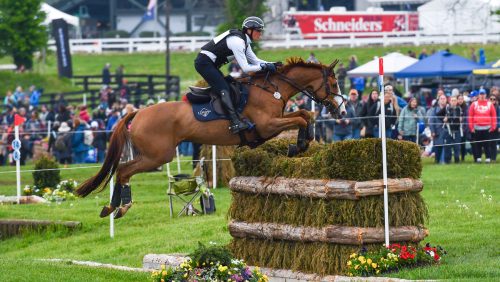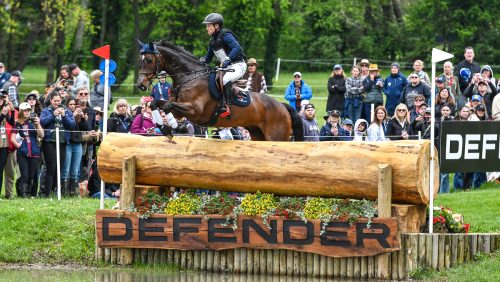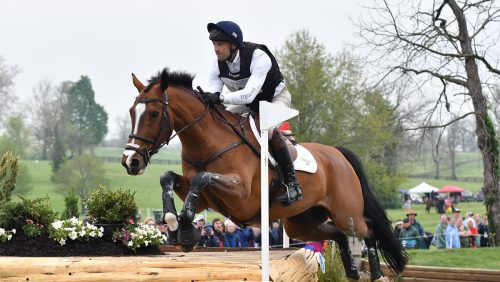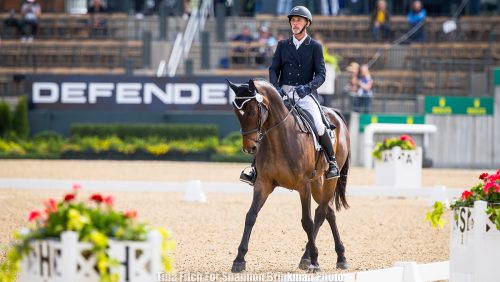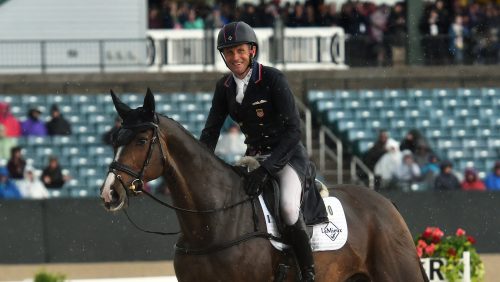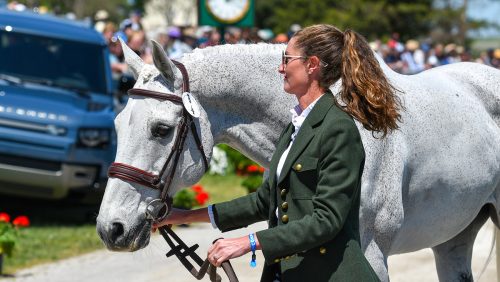In early 1976, Mary Hazzard and Bruce Davidson asked me to join a committee to start an event with the Delaware Valley Combined Training Association. This event had been held for several years at Mark Wilcox’s Ivy Mill Farm in Media, Pennsylvania.
At that time, I had no interest in being involved in the administration and organization of a horse trial. My life was full enough with my young family, a demanding job with IBM, and my own riding aspirations. I never realized how life-altering attending that meeting would be. For the past 45 years, except for 1985, I have been either the organizer, a member of the committee or course designing—and sometimes doing all those jobs at once!
In the 1970s there were three vital components to having a successful event at any level: the physical site, the quality of logistical support, and the financial resources available to initiate and sustain the horse trial. Those three components remain true in 2024. Regardless of the objectives, each one of these components is critical to the success of the competition.
Eventing has evolved considerably over the past five decades, and many of those changes—including improvements in turf maintenance, course design and safety—have benefitted the sport greatly. However, every improvement comes with a cost, and from almost the beginning, those costs have been carried by organizers while an outside entity, such as the U.S. Equestrian Federation, administrates the sport and deems what those costs will be.

We are now at a point where the costs of running an event have severely impacted organizers’ ability to break even, much less turn a profit that can be reinvested in their venues. Increased costs and outside regulation have been the death knell for many once-popular venues—Richland Park (Michigan), Jersey Fresh (New Jersey) and Great Meadow (Virginia) to name a few—and threaten the future of many others. We have fewer events nationwide than we did five years ago. How did we get here?
The Evolution Of The Sport
Any successful event will have an individual or group of trailblazers that made the event successful. Without those individuals, the event will fail. For example, years ago the Radnor Three-Day Event (Pennsylvania) could be compared to the Kentucky Three-Day Event. Unfortunately, when Radnor’s leadership retired, and its financial security became uncertain, this great event was no longer held.
Event organizers and committee members must understand that no two events have the same organizational model or financial model. Although some similarities exist, each event starts and evolves depending on the resources available. Most events have people in their community who volunteer their time and expertise to the event.
Plantation Field Equestrian Events, which I founded and ran for many years in Unionville, Pennsylvania, is a good example. The event is fortunate to have a fourth-generation farming family involved in Hicks Brothers IV. Owner Jamie Hicks, who is married to eventer Kate Ditchey Hicks, is a board member and hero without a cape. Jamie repairs equipment and infrastructure, donates equipment, and is always available with his crew in critical moments. Hicks Brothers IV is vital to the success of the Plantation Field International CCI.
For the past decade, the Plantation Field committee focused on turf management and development, aided in large part by Hicks Brothers IV, which maintains the course and works closely with experts to continue to improve the footing. From April to October, the tractors are rarely idle as Plantation crews work on over-seeding, adding mushroom soil, aerating, removing rough areas and moving with a finishing mower before competitions—important work with significant labor and fuel costs. Most events in the U.S. and abroad have these types of local arrangements, which are rarely accounted for on the financial statements, nor are they understood by the USEF. Many events would not be held without the support of these local contributors.
“We are now at a point where the costs of running an event have severely impacted organizers’ ability to break even, much less turn a profit that can be reinvested in their venues.”
Another major change is in the evolving logistical resources available for events. As officials’ jobs turn from avocation to vocation, many positions have become costly for event organizers. In the past, technical delegates would arrive on a Friday and charge for a half-day. Today, you pay for all three days. Officials’ costs, course costs and safety costs have all increased. This makes it challenging for organizers to be financially successful. At the international horse trials, official costs have doubled.
Course design and presentation are also very costly. Even when organizers design their own courses with some technical support from USEF, that can cost over $100,000. The course designers for the Maryland 5 Star at Fair Hill were paid $250,000. Plantation Field International course designers have ranged from a low of $60,000 to a high of $150,000. Medical costs have increased from $6,000 to $16,000. Official costs, course design, building and presentation and safety coverage are all very much improved and needed. However, those three costs, when divided by the entry money for the international divisions, would show a huge loss.
Another dynamic that has evolved in our sport is understanding the words “want versus need.” An organizer who can’t buffer competitors’ “we want” comments will have a hard time financially. Last year a comment by one competitor led an organizer to add an upper-level division without going through a needs or cost-benefit analysis first.
The relationship between event organizers and competitors has changed significantly over the past 45 years. Competitors in the 1970s did not have many choices; they were just pleased that someone was stepping forward and having an upper-level event. The U.S. Equestrian Team subsidized most advanced trials, with assistance from major sponsors like Rolex in Kentucky or Almaden at Chesterland in Unionville, Pennsylvania.
In the late 1980s, under the leadership of Jack Fritz, the USET assisted intermediate events with grants. This program was very successful at getting this level established. As eventing continued to grow through the 1990s, it was still controlled by one committee, the name of which changed multiple times over the years, that made major decisions for the sport.
ADVERTISEMENT
The physical site requirements for events have changed tremendously over the years—in most cases for the better. In the early years, if an organizer had the minimum requirements and was willing to hold the event, everybody pulled together to make it happen. Today, the “want versus need” can be a double-edged sword with a blade sharp enough to end events.
For the past 20 years, competitors have identified the need for better footing and improved courses. One of the best decisions made by USEF was the hiring of Capt. Mark Phillips in 1993. His level of expertise was light years ahead of American designers.
Mark’s greatest asset was his ability and self-confidence to allow U.S. designers to learn and grow without the need for him to gain ownership of the course. In my personal experience with Mark, he very patiently took my ideas and made suggestions that significantly improved the design. In the early 1980s, Bruce Davidson’s Chesterland Farm built permanent dressage rings—a novelty in a time where grass rings were the norm. Stadium jumping, too, was usually not on a completely level surface.
Today, most dressage and stadium phases in this country are held in rings with prepared surfaces. About five years ago a top U.S. rider predicted that within two years all four-stars (now five-stars) would need to have permanent footing—quite a statement when you consider that Badminton and Burghley in England are still held on grass, as were the 2022 FEI Eventing World Championships (Italy).
The Calendar Process
In my opinion, the relationship between event organizers who carry the financial risk of hosting a competition and the USEF is imbalanced and one-sided. The organizers’ needs and views are often ignored in the decision-making process. A good example is the USEF eventing calendar. The USEF Eventing Bid Review Group formulates and manages the event date selection bid program for events throughout the country.
When the bid process was established in 2021, organizers were sent an invitation to bid around May 1 and given 30 days to submit a detailed bid for their events to be included on the 2023-2027 calendar. Every event was, and now is, required to submit a bid that must be approved by the bid review group and USEF board of directors if they want to host a CCI4*-L, CCI4*-S, CCI3*-L or advanced division at their competition. The process was the same for all competitions, regardless of whether they were established international events that had been on the calendar for years or brand-new competitions.
Organizers had a right to feel left out of the process. A cursory review of the bid review group shows that not a single member carries the financial risk for a major international event. When I last looked, the committee did have professional event managers, but those are people who, if an event fails, can move on to another venue. The less-than-positive effects of the USEF Scheduling Committee, even before the bid process, have been well documented.
Prior to the bid process, the organizers of Richland Horse Trials asked to add an intermediate division to their schedule. They were turned down because there was an intermediate division offered at Kentucky Horse Park a week away from their date. Richland then canceled their event.
Again in 2023, the results of the calendar process have been less-than-ideal because the committee did not communicate with organizers to find out if their events could change dates. On the East Coast, Jersey Fresh has been canceled. Red Hills (Florida) canceled because they could not move one week later to satisfy the committee. The Fork (North Carolina) canceled but rescheduled for the fall. The ripple effect to Area II spring events was devastating. Area II competitors who normally would come home after Carolina International (North Carolina) stayed south until after Tryon. Plantation Field alone had 200 fewer horses in its USEF-recognized spring trials. Long-term, those changes in competitive habits will drastically hurt the events that lose entries because of them.
To put this in perspective, imagine if the USEF jumper committee approached the historic Devon Horse Show (Pennsylvania) and asked it to move its hugely popular grand prix from Thursday night to Monday. This standing-room-only evening draws thousands of spectators and revenue for Devon and has been a long-standing Thursday night tradition.
When organizers raise concerns about how the calendar process is being carried out, they are accused of trying to “protect their dates” and told they do not want competition. This is a short-term criticism. In fact, the organizers that have been involved in promoting eventing from the 1980s to today understand the effort which made this happen. Just as importantly, they understand the possible long-term effects that many decisions will cause.
“When organizers raise concerns about how the calendar process is being carried out, they are accused of trying to ‘protect their dates’ and told they do not want competition.”
Because many will view this article in a negative manner, I would ask all to consider possible short-term and long-term solutions. Short term, no new rule or regulation should be passed without having a cost analysis as to the impact on an event. Some form of communication must be created so that organizer input is provided before decisions are made.
At the upper-level events, there must be some review process before a calendar change is announced. The methodology for making changes in schedules must be reviewed. If an event in Area III wants to add a date, they face little pushback from another area who may have an event on the proposed weekend. The reality is that many events, especially in busy areas, are not getting the same number of entries as they did prior to the calendar changes. Without enough starters, organizers don’t earn the revenue needed to reinvest in the event.
Preparing For International Competition
ADVERTISEMENT
There has been significant feedback that the current spring schedule is not preparing horses for the five-stars at Kentucky and Badminton. While having the financial resources available to put on an upper-level event is imperative, the land that event is held on still must have the terrain and the courses necessary to prepare horses for the advertised level, and in our country we have an acknowledged problem with courses, particularly at the four-star level, being inconsistent in their difficulty.
We also seem to have developed a cultural problem as it pertains to footing and those who retire on course. At the Plantation Field International event last year, heavy rain made competing a challenge. Many competitors withdrew before cross-country. However, as both Caroline Pamukcu and Ariel Grald pointed out, if you want to run in Europe and England, you have to learn to compete on this footing. Badminton and the FEI European Championships were conducted on more challenging footing than what was experienced at Plantation Field International this year.
Footing needs to be considered a component of a competition. When a competitor withdraws because they feel the footing is not up to their liking, I feel it’s because they don’t want to compete. The reality is that, if you have competing in the United Kingdom or Europe in your long-term plans, you need to gain experience competing on all types of ground. Events held where there is “great footing because it’s sand” may be fine as qualifiers but do little to acclimate a horse to handling diverse conditions, whereas events in Mid-Atlantic states may have rain, mud and imperfect footing.
Even if it doesn’t rain, some of the biggest events in the world stage dressage and show jumping on grass—far from the all-weather footing now ubiquitous in U.S. venues. (It would be interesting to know how many times the American horses schooled on grass surfaces prior to the world championships in Italy.) I don’t know of a single, major European event that has footing like that found in the Southeastern U.S.
My opinions stated in this article are based on my love of eventing and my 63 years of exposure to the sport. The comments and questions I raised are crucial in determining the future of eventing. I have tried to identify the evolution of the sport and focus on those issues which will impact and determine our sport’s existence.
Is the sport going to contract to where all competitions are held at a handful of major venues that can guarantee sandy cross-country turf and all-weather footing for jumping and dressage, and horses jump those same courses in those same conditions over and over? Or are we going to focus on teaching the skills needed to compete at the upper levels of cross-country? It’s up to the powers to be to define what the sport will be and how it will be sustained.
Denis Glaccum is a former member of the U.S. Equestrian Team’s Three-Day Event Committee, former secretary, vice-president and board member of the U.S. Combined Training Association (now U.S. Eventing Association), former president of the American Horse Trials Foundation, and former chairman of the USEA Strategic Planning Committee and Organizers Committee. In addition, Glaccum has served on the U.S. Equestrian Federation Events and Course Designing Committees.
In 2001, Glaccum, who spent 18 years working for IBM before he returned to the horse world full time, initiated the running of the horse trials at Plantation Field in Unionville, Pennsylvania, which he served as the director and organizer of until 2013.
During his earlier years, he was twice named the USCTA rider of the year, and he trained for two years with the U.S. Equestrian Team and showed at the National Horse Show in Madison Square Garden, New York, in four different disciplines. He competed in horse trials from 1956 to 2012.
In 2000, the USEA honored his long-term commitment to the sport with the Wofford Cup, and he was inducted into the USEA Hall of Fame in 2009. He still maintains a small breeding, training, sales and working student program in Unionville and at his farm in Aiken, South Carolina.
This article originally appeared in the March 2024 issue of The Chronicle of the Horse. You can subscribe and get online access to a digital version and then enjoy a year of The Chronicle of the Horse. If you’re just following COTH online, you’re missing so much great unique content. Each print issue of the Chronicle is full of in-depth competition news, fascinating features, probing looks at issues within the sports of hunter/jumper, eventing and dressage, and stunning photography.






